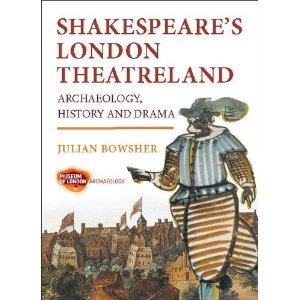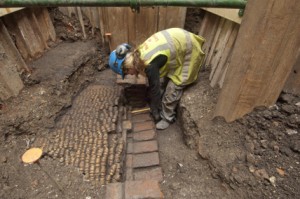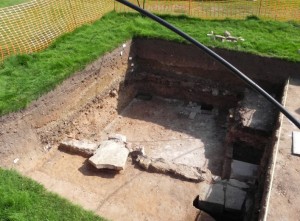Anyone going in search of Shakespeare’s London thirty years ago would have found little to satisfy them. The City and its surroundings has been occupied for hundreds, even thousands of years, and successive generations have built and rebuilt it. The Great Fire of London in 1666 and the 1940 blitz were dramatic events that obliterated landmarks which Shakespeare would have recognised. Westminster Abbey and the Tower of London are two of the few buildings still standing that Shakespeare would have recognised.
As for that most famous of buildings, the Globe Theatre, the metal plaque fixed to a wall was the only visible sign that Shakespeare’s theatre had ever been. Unlike churches and royal palaces, playhouses were never meant to be permanent, so how could there be anything left?
But gradually, over the last three decades, buildings from Shakespeare’s London have begun to emerge. From being just dots on a map, actual remains have started to be uncovered from beneath the London street scene. They’ve been there all along, for four hundred years, just waiting. It seems like a miracle, but it has now been possible to excavate no fewer than six Elizabethan and Jacobean playhouses and two bear-baiting rings.
 A new book by Julian Bowsher, Shakespeare’s London Theatreland, tells the story of the buildings and how they have been found. The organisation for which he works, Museum of London Archaeology, has done amazing work in rediscovering these lost buildings. Bowsher joined MOLA as a professional archaeologist in the mid 1980s and the first major discovery, the Rose Theatre, was made in 1989. He is now a specialist in the archaeology of the Tudor and Stuart periods and the book is written from the unique perspective of his personal experience.
A new book by Julian Bowsher, Shakespeare’s London Theatreland, tells the story of the buildings and how they have been found. The organisation for which he works, Museum of London Archaeology, has done amazing work in rediscovering these lost buildings. Bowsher joined MOLA as a professional archaeologist in the mid 1980s and the first major discovery, the Rose Theatre, was made in 1989. He is now a specialist in the archaeology of the Tudor and Stuart periods and the book is written from the unique perspective of his personal experience.
It’s not just a series of dry reports, but a beautifully-illustrated and engaging account of the subject from a number of different angles. Inevitably the main focus is on the excavations and what they tell us about the buildings. Photographs of excavations can be difficult to interpet, but not here, with important details marked with superimposed dotted lines. The excellent plans, reconstructions and photographs, all in colour, really make you understand what you’re looking at.
Some of the most interesting questions which archaeology has helped to answer are about how the buildings worked as playhouses: the shape and size of the stages for instance. Bowsher’s authoritative voice when speaking about the digs is matched with material from reliable secondary sources on the history of the theatres themselves.
As well as talking about the buildings Bowsher also gives an account of the people who built and worked in them. The players have been brought to life, with finds including fragments of costumes and props, and even the audiences left their mark: fruit seeds and nutshells were found in the Rose excavation.
Bowsher doesn’t stray far away from his area of expertise, so you won’t find accounts detailing the repertoire of the various theatres, but this is discussed at length in many other publications. The book exposes how much of Elizabethan London does still exist, and shows that we can still connect with it. Earlier this year we all felt the tingle of excitement when the news broke that remains of the Curtain Theatre in Shoreditch, a playhouse Shakespeare wrote for early in his career, had been found, coming just in time to be included in this book.
And one feature of the book that I love is a guide to eight walks around the city, so that we can identify places long gone, see those that still remain, and understand how they are connected. Walking gives a different perspective, and it’s a surprise to realise how much of the street plan of Shakespeare’s London still exists among the huge office blocks. It does make you wonder how much there still may be to find under buildings, roads, and car parks.
It isn’t possible to talk about Shakespeare and archaeology at the moment without mentioning the excavations under a Leicester car park which are revealing, possibly, the grave of Richard III. At the time of writing bones have been found with wounds that indicate the person died in battle and that indicate curvature of the spine, both of which tie up. But archaeologists are being cautious. DNA samples have been taken from someone who is a direct descendant of Richard’s sister: a really positive identification from such a remote relation sounds optimistic to me. We will have to wait and see.
And in Stratford the Dig for Shakespeare has widened its brief from looking for remains of Shakespeare’s last home at New Place to opening up a trench in the Great Garden where they have found the remains of the first purpose-built permanent theatre in Stratford, demolished in 1872. The link with Shakespeare is remote, but it is pleasing to see some attention being paid to this building which has been almost completely forgotten.





Pingback: Archaeology and Shakespeare: London, Leicester and Stratford | The Shakespeare blog : Past Horizons Archaeology
Fascinating. I knew the Trust were talking about looking for the 1827 theatre, but did not realise they had actually started. I wonder if they know that there’s a ground plan in the Folger? I also saw in a magazine recently that Janet Suzman and Michael Pennington are heading a campaign to ?re-excavate/re-interpret The Rose. There are apparently direct descendants of Clarence living in Australia, so if there is a possible DNA match with Richard, perhaps a cross-reference is intended with them. All that would then remain would be the vexed question of where to re-inter the bones.
Thanks for this. I had forgotten that the Folger had a ground plan of the 1827 plan. Is it part of the Halliwell-Phillips papers? On the subject of the Richard III debate, until last week the story about Richard having a hump was meant to be a piece of evil Tudor propaganda, with paintings being changed to show this deformity. Now, the spinal illness confirms the theory that the bones are Richard’s!
Well, not exactly… It’s long been speculated that Richard may have had one shoulder a little higher than the other – a physical quirk that could later be exaggerated to suggest monstrosity. Even his most adulatory biographer, Kendall, mentions this and suggests possible causes. But that doesn’t equate to a hunchback. In fact, the osteoarchaeologist at Leicester cited scoliosis and specifically ruled out kyphosis. Scoliosis is comparatively common – my mother has it, as does, apparently, Usain Bolt. Neither could be described as deformed. And, in fact, as someone who works for a disability charity I’m rather disappointed by the easy use of the term “deformity” in this context.
Thank you so much for this helpful explanation!